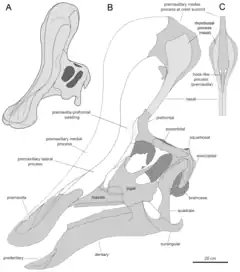Tsintaosaurini
Les Tsintaosaurini forment une petite tribu éteinte de lambéosaurinés basaux, hadrosauridés d'Eurasie, ayant vécu à la fin du Crétacé supérieur (Campanien et Maastrichtien)[2].

Genres de rang inférieur
Ce petit clade ne contient que deux genres :
- Tsintaosaurus découvert dans la province de Shandong dans l'est de la Chine ;
- Pararhabdodon découvert dans le nord de l'Espagne et le sud de la France[3] - [4].
Le genre Koutalisaurus, découvert dans les mêmes niveaux stratigraphiques de la fin du Crétacé en Espagne, est parfois considéré comme un Tsintaosaurini en raison de cette association. Il pourrait être un Pararhabdodon[5] - [6] - [7] ou rester un lambéosauriné indéterminé[2].
Classification
Cladogramme
Le cladogramme suivant a été réalisé par Albert Prieto-Márquez et ses collègues en 2013, il montre la phylogénie des lambéosaurinés[2] :
| Lambeosaurinae |
| ||||||||||||||||||
Un cladogramme plus large, plus complet et plus récent, établi par les mêmes auteurs en 2016, se trouve dans l'article Hadrosauridae[8].
Notes et références
Références
- (en) A. Prieto-Márquez et J. R. Wagner, « The ‘Unicorn’ Dinosaur That Wasn’t: A New Reconstruction of the Crest of Tsintaosaurus and the Early Evolution of the Lambeosaurine Crest and Rostrum », PLOS ONE, vol. 8, no 11, , e82268 (DOI 10.1371/journal.pone.0082268)
- (en) A. Prieto-Marquez, F. M. D. Vecchia, R. Gaete et A. Galobart, « Diversity, relationships, and biogeography of the Lambeosaurine dinosaurs from the European archipelago, with description of the new aralosaurin Canardia garonnensis », PLOS ONE, vol. 8, no 7, , e69835 (PMID 23922815, PMCID 3724916, DOI 10.1371/journal.pone.0069835)
- Laurent, Y., LeLoeuff, J., & Buffetaut, E. (1997). Les Hadrosauridae (Dinosauria, Ornithopoda) du Maastrichtien supérieur des Corbières orientales (Aude, France) [The Hadrosauridae (Dinosauria, Ornithopoda) from the Upper Maastrichtian of the eastern Corbières (Aude, France)]. Revue de Paléobiologie 16:411-423
- (en) http://www.plosone.org/article/info%3Adoi%2F10.1371%2Fjournal.pone.0069835
- (en) Casanovas, M.L, Pereda-Suberbiola, X., Santafé, J.V., and Weishampel, D.B. 1999. First lambeosaurine hadrosaurid from Europe: palaeobiogeographical implications. Geological Magazine 136(2):205-211
- (en) Prieto-Marquez, A., Gaete, R., Rivas, G., Galobart, Á., and Boada, M. 2006. Hadrosauroid dinosaurs from the Late Cretaceous of Spain: Pararhabdodon isonensis revisited and Koutalisaurus kohlerorum, gen. et sp. nov. Journal of Vertebrate Paleontology 26(4): 929-943
- (en) A. Prieto-Márquez et Wagner, J.R., « Pararhabdodon isonensis and Tsintaosaurus spinorhinus: a new clade of lambeosaurine hadrosaurids from Eurasia », Cretaceous Research, vol. preprint, no 5, , p. 1238 (DOI 10.1016/j.cretres.2009.06.005)
- (en) A. Prieto-Marquez, G.M. Erickson et J.A. Ebersole, « A primitive hadrosaurid from southeastern North America and the origin and early evolution of 'duck-billed' dinosaurs », Journal of Vertebrate Paleontology, vol. 36, no 2, , e1054495 (DOI 10.1080/02724634.2015.1054495)
Voir aussi
Références taxinomiques
- (en) Référence Paleobiology Database : Tsintaosaurini Prieto-Marquez et al., 2013